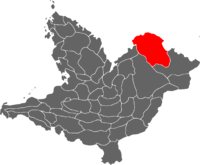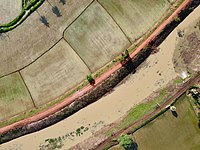Yajawil of Xukaj: Difference between revisions
No edit summary |
|||
| Line 148: | Line 148: | ||
Hydroelectricity is the main source of energy for the Viceroyalty, overing around sixty percents, which is around the Mutul' national average but less than its southern neighbor of [[Yajawil of Nohkaj|Nohkaj]] (81%). Electric production is done both by {{wp|Run-of-the-river hydroelectricity|run-of-the-river}} and {{wp|Reservoir}}s dams. Another 10 percents of the electric production come from {{wp|Photovoltaic power station|solar farms}} and another 10% from {{wp|Biomass}} and agricultural residues. As a result, Xukaj is almost autonomous, energy-wise, from the rest of the Mutul importing only 20% of its electricity needs in the form of oil products, coal, and natural gaz from the rest of the country (15%) and the rest from miscellaneous import from [[Orun Redisus]] and other countries. | Hydroelectricity is the main source of energy for the Viceroyalty, overing around sixty percents, which is around the Mutul' national average but less than its southern neighbor of [[Yajawil of Nohkaj|Nohkaj]] (81%). Electric production is done both by {{wp|Run-of-the-river hydroelectricity|run-of-the-river}} and {{wp|Reservoir}}s dams. Another 10 percents of the electric production come from {{wp|Photovoltaic power station|solar farms}} and another 10% from {{wp|Biomass}} and agricultural residues. As a result, Xukaj is almost autonomous, energy-wise, from the rest of the Mutul importing only 20% of its electricity needs in the form of oil products, coal, and natural gaz from the rest of the country (15%) and the rest from miscellaneous import from [[Orun Redisus]] and other countries. | ||
===Manufacturing=== | |||
The traditional main industry of Xukaj is the {{wp|Textile industry}}, notably with the production of {{wp|Mola (art form)|Mola clothes}}, a textile specific to the Viceroyalty and associated mainly with the {{wp|Guna people|Dule}}. The region is also a producer of natural and chemical dyes, cotton (from Cultivation to Weaving and Finishing), and {{wp|Synthetic fiber|artificial fibers}}. It is the second largest employment generating sector in Xukaj, behind agriculture. The Dule and Ch'olti merchant-nobility of the region was the first part of the Mutulese' Elite to have truly embraced the industrial revolution, with the first {{wp|Cotton mill}} opening in the region at the beginning of the 19th century, even before the [[Sajal War]] and the Itzamnaaj Reforms of the 1840s. | |||
The other major industries of Xukaj include {{wp|shipbuilding}}, {{wp|Pharmaceutical industry}}, {{wp|Electronics industry|electronics}}, and leather goods manufacturing. A significant part of the Viceroyalty' economy is aimed at providing manufactured goods to the neighboring countries of [[Orun Redisus]] and [[Sante Reze]], with enterprises from these countries delocalising their factories to the Mutul to take profit from the cheaper production costs. Both [[Pantra A.E]] and [[Aldmerta Automotive]], the main automotive producers of Orun Redisus, have the majority of their assembly plants in Xukaj. | |||
==Culture== | ==Culture== | ||
[[category:Mutul]] | [[category:Mutul]] | ||
[[category:Mutul Administrative divisions]] | [[category:Mutul Administrative divisions]] | ||
Revision as of 11:41, 18 November 2022
Yajawil of Xukaj | |
|---|---|
| Motto: United Voices | |
| Anthem: Hymn for the Communion | |
 Location of Xukaj in the Mutul | |
| Capital and | Puylum |
| Official languages | Mutli |
| Recognised national languages | |
| Ethnic groups (2020) | |
| Demonym(s) | Xukajeses |
| Government | Absolute monarchy |
| Legislature | Chika Holpop |
| Chika Sajal Ch'ob | |
| Chika Mam Ch'ob | |
| Province of the Mutul | |
| Area | |
• | 138,512 km2 (53,480 sq mi) (2nd) |
The Yajawil of Xukaj is one of the two southernmost provinces of the Mutul. Centered around the lower beds of the Kuwajuwa and Chetzaj rivers, its capital Puylum is located at the mouth of the former on the Kayamuca Sea' coast. It shares a land border with the kingdom of Orun Redisus to the east as well as with the other Mutuleses provinces of Nolkaj to the south-east, Yajumel to the south-west, and Jalchi to the west. It is the second largest Viceroyalty of the Mutul, right behind its neighbor Yarumel (162,016 km²).
The original inhabitants of the Province were speakers of various Chibchan languages of which Dule and U'wa peoples are modern representatives. The region is known as an important agricultural and industrial center for the Divine Kingdom with strong commercial relations with its neighbor, other countries in the Kayamuca Sea, and Sante Reze.
It is a very ethnically diverse region where the dominant Ch'olti culture only arrived during the 14th century and wouldn't become the norm until the 1800s. This leave the region as home to different White Path denomination and temples, many of which find their roots in the antique Chibchas religious practices which put the emphasis on the Voice, generally through religious songs and oral traditions.
Etymology
Geography
The region features two of the longest rivers in the Mutul, the Kuwajuwa and Chetzaj rivers, on the shores of which humans have settled since prehistoric times. The natural vegetation of the region has for the most part dissapeared and survive mostly in the more mountaineous area. In the rest of the country, the dominant form of agriculture allowed by irrigation canals fed by water from the two rivers has heavily altered the environment of the province.
Climate
Most of the Viceroyalty has a Tropical monsoon climate, a tropical climate with a short dry season and heavy rainfall for the majority of the year. In the Köppen climate classification, it is classified under the letters Am. Tropical rainforest is the natural vegetation, and also provides the other climate type located in the state.
History
Politics
Economy
Agriculture
Xukaj is rich in water, with its two major rivers feeding many rivers, reservoirs, and wetlands, but poor in quality soils. As a result, most of the production is done through a system of Raised fields. Beside producing electricity and securing access to freshwater for the region, the artificial lakes created by Hydroelectric dams are also the reservoirs feeding a complex system of canals used both for the transport of goods and for the irrigation of the Raised Fields. Those canals are also used since pre-classic times for pisciculture where the Eutrophication of the water is avoided by using the fish wastes, muds, and other sediments accumulating within the canals as fertilizer for the fields.
Raised fields are privately owned and exploited intensively and industrialy with one field corresponding to one agricultural product (although which one may vary from year to year). Xukaj is a net exporters of products such as Maize, cotton, tobacco, sugar cane, and pineapple. Fish farms also produce cichlids but also introduced species such as shrimps, Grass carps, and so on.
The Xukaj face many challenges due to its model of production, including the threat of Pesticides and chemical Fertilizers on water quality, human health, and fishing. Population growth has also led to a reduction in farmlands, the raised fields being instead "fortified" with concrete and used as foundation for new urban agglomerations, a movement accompanied with the growth of the road network of the region which further aggravate the problem soil artificialisation and place threats not only on food production and human health, but also on the populations' resilience to natural disasters such as hurricanes or floods.
Energy production

Mut-Ek'taha, the state-owned oil company of the Mutul, is present in Xukaj where it is involved in various operation. It has financed multiple Biofuel production ventures in the Viceroyalties, investing in research and development of Biogasoline, Algae fuel, Ethanol fuel and other "alternative" sources of gasoline. After the discovery of off-shore oil reserves in the neighboring Orun Redisus' national waters, Mut-Ek'taha had begun its own program of exploration in the area, with little success. Most of the oil produced by the Mutul is still extracted from the Gulf of Ochk'ak'n'ab, on the other side of the country.
Hydroelectricity is the main source of energy for the Viceroyalty, overing around sixty percents, which is around the Mutul' national average but less than its southern neighbor of Nohkaj (81%). Electric production is done both by run-of-the-river and Reservoirs dams. Another 10 percents of the electric production come from solar farms and another 10% from Biomass and agricultural residues. As a result, Xukaj is almost autonomous, energy-wise, from the rest of the Mutul importing only 20% of its electricity needs in the form of oil products, coal, and natural gaz from the rest of the country (15%) and the rest from miscellaneous import from Orun Redisus and other countries.
Manufacturing
The traditional main industry of Xukaj is the Textile industry, notably with the production of Mola clothes, a textile specific to the Viceroyalty and associated mainly with the Dule. The region is also a producer of natural and chemical dyes, cotton (from Cultivation to Weaving and Finishing), and artificial fibers. It is the second largest employment generating sector in Xukaj, behind agriculture. The Dule and Ch'olti merchant-nobility of the region was the first part of the Mutulese' Elite to have truly embraced the industrial revolution, with the first Cotton mill opening in the region at the beginning of the 19th century, even before the Sajal War and the Itzamnaaj Reforms of the 1840s.
The other major industries of Xukaj include shipbuilding, Pharmaceutical industry, electronics, and leather goods manufacturing. A significant part of the Viceroyalty' economy is aimed at providing manufactured goods to the neighboring countries of Orun Redisus and Sante Reze, with enterprises from these countries delocalising their factories to the Mutul to take profit from the cheaper production costs. Both Pantra A.E and Aldmerta Automotive, the main automotive producers of Orun Redisus, have the majority of their assembly plants in Xukaj.
